You only need 7 ingredients to make these dinner rolls. Flaky, soft, and buttery, these fresh dinner rolls outshine any main dish. If you’re a bread beginner, read this blog post to learn more about the yeast rolls recipe, including how to prep the rolls ahead of time. You can also reference my Baking with Yeast Guide for answers to common yeast FAQs.
This recipe is brought to you in partnership with Red Star Yeast.
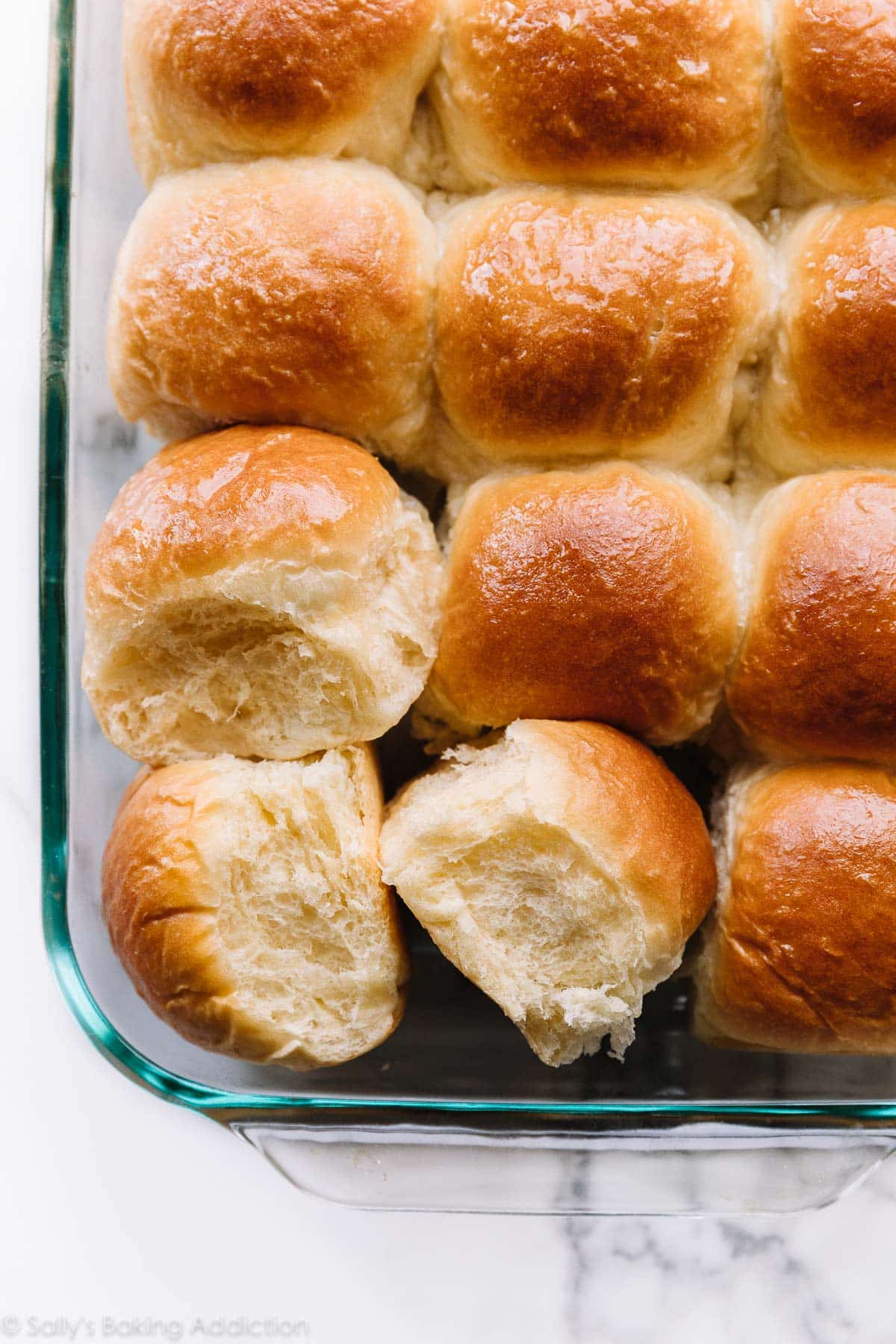
- Do you long to bake homemade bread but are too intimidated to start?
- Does yeast dough send you running for the hills?
- Do bread recipes seem overly complicated and confusing?
I’m teaching you how to make homemade dinner rolls. These are the best homemade dinner rolls I’ve ever had and it all starts with a straightforward 7-ingredient dough. I make these rolls whenever I get the chance and even brought a pan to our friends who just welcomed a baby. They’re pillow-soft with the most delicious flaky and buttery texture. Everyone will demand you bake them on repeat.
And with this recipe, I guarantee you will finally feel confident baking bread. 🙂
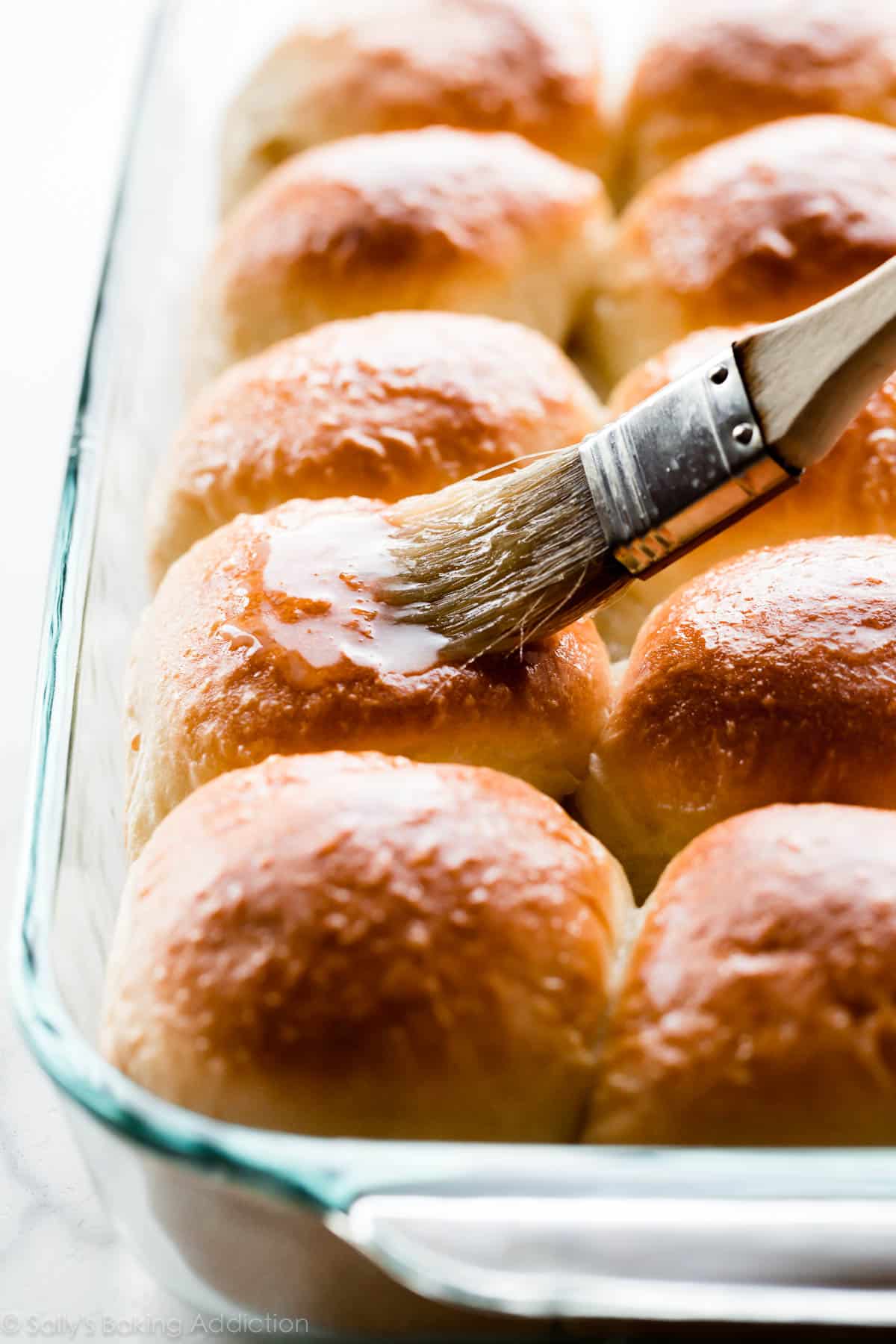
Video Tutorial: Dinner Rolls
Let’s start with a video tutorial.
Overview: How to Make Homemade Dinner Rolls
- Make the dough. Continue below to learn more about this dough recipe.
- Knead the dough. Reference my How to Knead Dough video tutorial if you need extra help with this step.
- Cover the dough and let it rise. The dough rises in about 1-2 hours in a relatively warm environment.
- Punch down the dough to release the air and shape into rolls.
- Let the rolls rise for about 1 hour.
- Bake for 20-25 minutes until golden brown. If desired, brush the warm rolls with a little honey and melted butter for extra flavor.
As shown in the video tutorial, the dough comes together with a mixer. You can use a paddle attachment or a dough hook. You can also make the dough by hand, but it requires a bit of arm muscle. After the dough comes together in the mixing bowl, it’s time to knead. You can simply continue beating the dough with the mixer for this step or you can knead the dough by hand. I chose to knead the dough by hand so you can see me doing it in the video above.
If you’re new to bread making, my How to Knead Dough post and video can help even more with this step. And my Baking with Yeast Guide is a wonderful resource for all bread beginners!
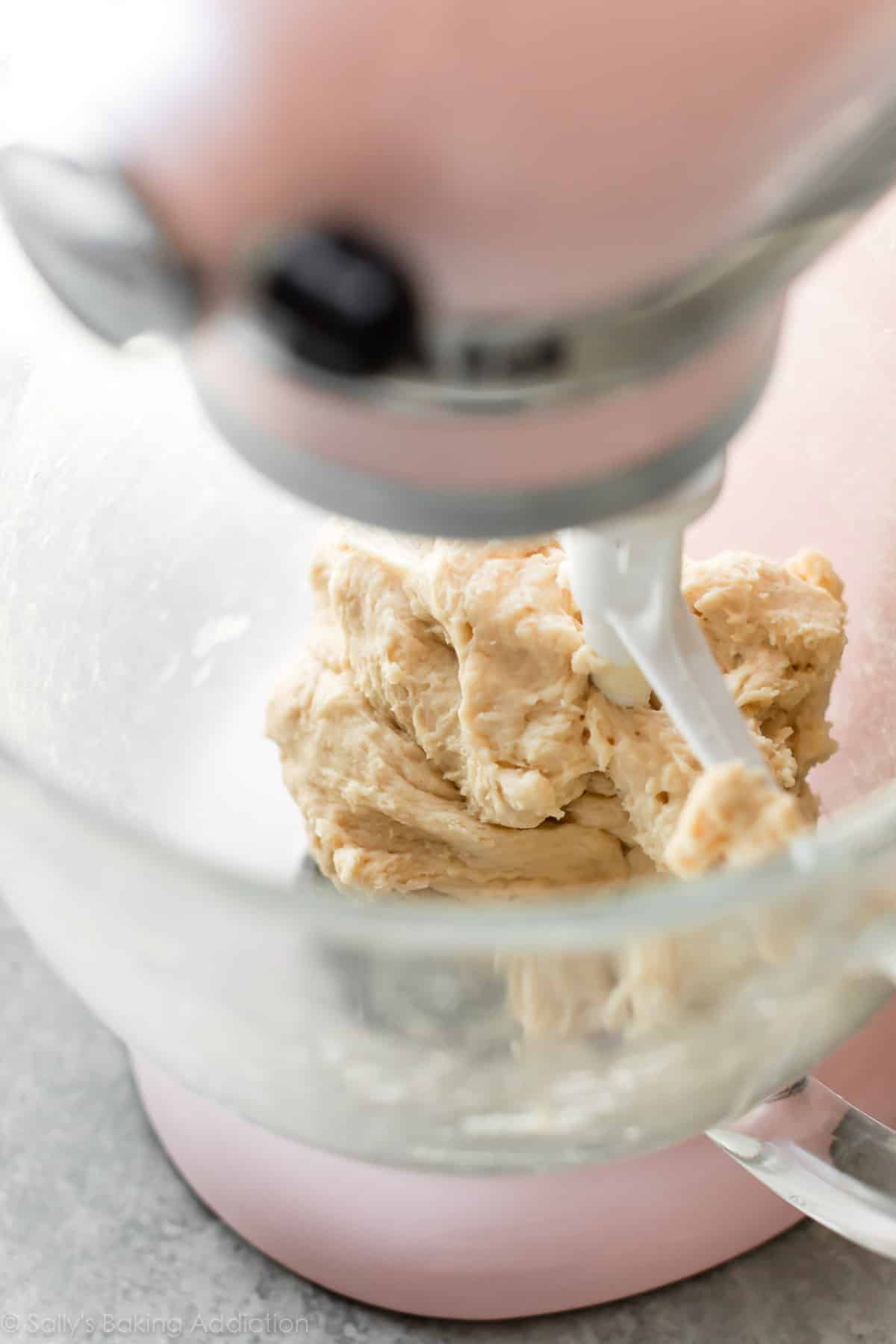
Soft Dinner Rolls Require a Rich Dough
The crustier and chewier the bread, the less fat in the dough. This is known as a lean dough. The softer and richer the bread, the more fat in the dough. This is known as a rich dough. Unlike chewy homemade bagels, focaccia, and my artisan bread, soft dinner rolls require a rich dough. Unfortunately, this doesn’t mean that the dough is swimming in cash. Rather, “rich” correlates with the amount of fat. For example, this dough has milk, butter, and egg.
You need 7 ingredients total. They’re the same ingredients in my easy cinnamon rolls, which is also a rich dough. (Though I use more sugar for sweeter cinnamon rolls, of course.)
- Milk: Liquid activates the yeast. For the softest dinner rolls, use whole milk. Nondairy or low fat milks work too, but whole milk produces phenomenal flavor and texture.
- Yeast: You can use active dry yeast or instant yeast. If using active dry yeast, the rise times will be a little longer. I recommend Platinum Yeast from Red Star, which is an instant yeast blended with natural dough improvers.
- Sugar: Sugar feeds the yeast, increases its activity, and tenderizes the dough.
- Egg: 1 egg provides structure and flavor.
- Butter: Butter promises a flavorful and soft dinner roll. Make sure it’s room temperature.
- Salt: You can’t make flavorful bread without salt!
- Flour: You can use all-purpose flour or bread flour in this recipe. All-purpose flour is convenient for most, but bread flour produces chewier dinner rolls. There are no other changes to the recipe if you use bread flour.
Once you make the dough, let it rise:
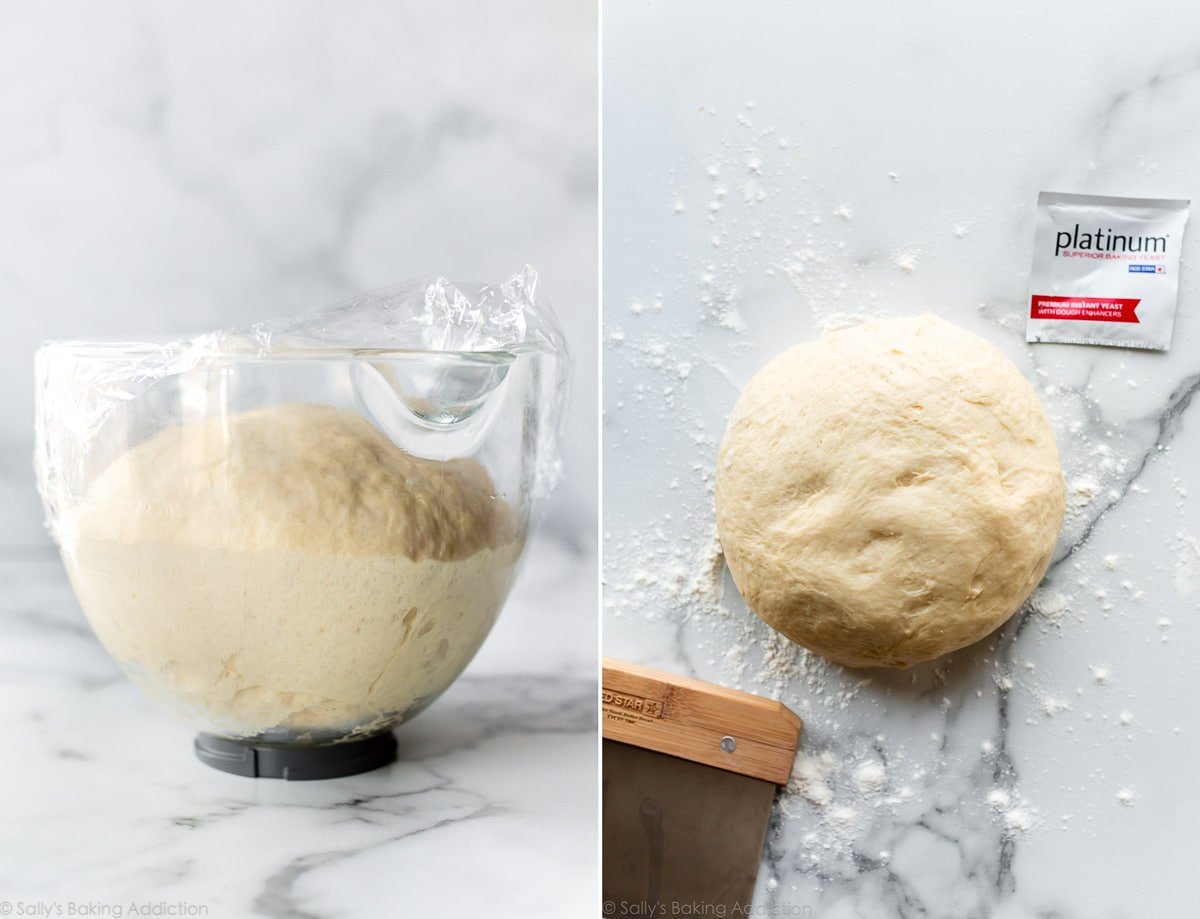
After that, punch down the risen dough. Shape into balls and arrange in a baking pan. Don’t worry if they’re not all uniform in size.
Let the shaped rolls rise before baking. Look how puffy they get after 1 hour of rising:
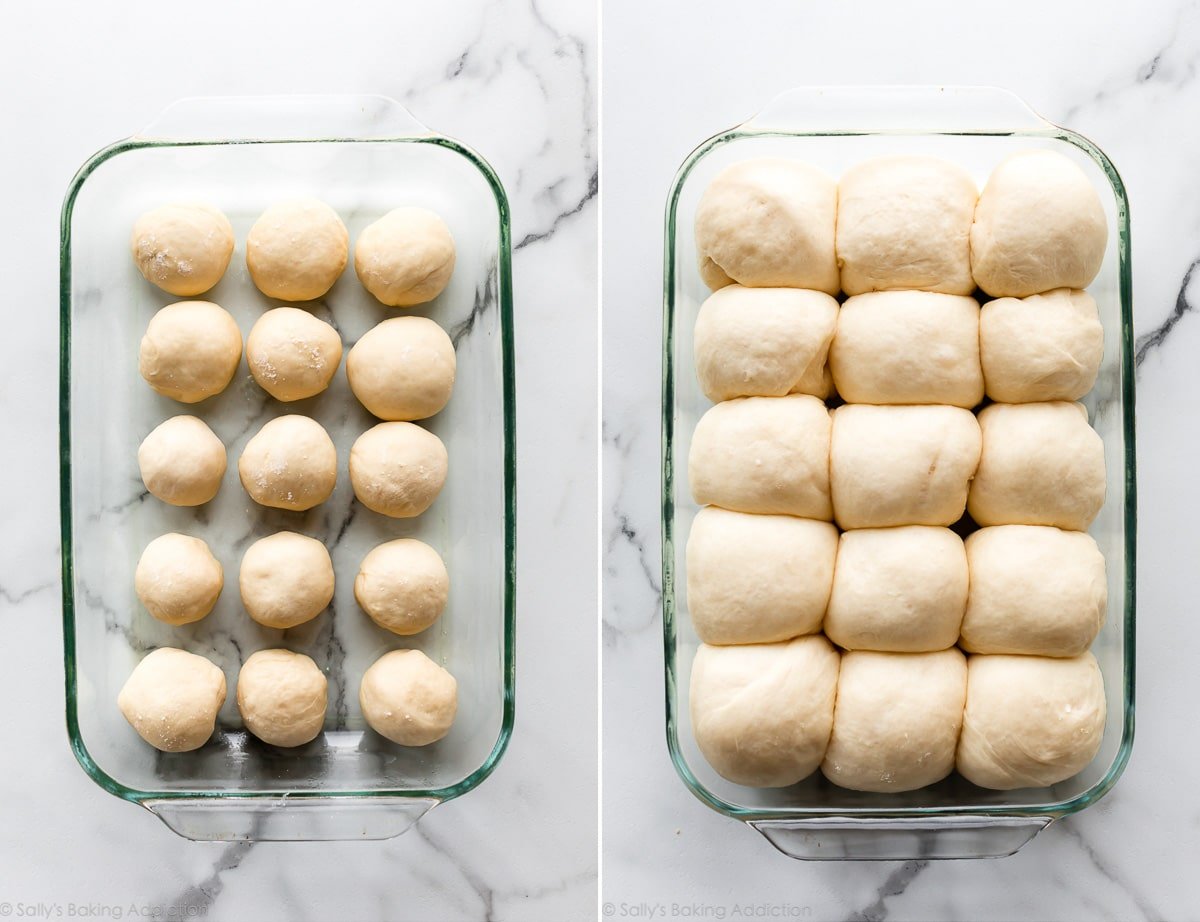
How to Shape Dinner Rolls
You can shape this dough many different ways including twisted rolls, knotted rolls (how I shape garlic knots), cloverleaf rolls, or even hot dog buns. Let’s stick with the basic round shape. Divide the dough into 14-16 pieces. Take a piece and stretch the top of the dough while pinching and sealing the bottom. Make sure the rolls are smooth on top and sealed on the bottom. I shape hot cross buns the same exact way.
How to Make Yeast Rolls Ahead of Time
The rolls require around 3 hours of rising. Not everyone has 3 hours to spare, so let’s discuss another option! Prepare the dough, let it rise, and shape the rolls. Cover the shaped rolls tightly and refrigerate for up to about 16 hours. At least 3 hours before you need them the next day, remove the rolls from the refrigerator and allow to rise on the counter for about 1-2 hours before baking.
And here’s how to freeze dinner rolls: Follow the make-ahead instructions and instead of refrigerating overnight, freeze the rolls in a baking pan. Once frozen, they won’t stick together anymore and you can place them in a freezer bag. Let them thaw and rise for about 4-5 hours, then bake. You can also freeze the baked dinner rolls. Therefore, if you want a smaller batch, you can make the entire recipe and bake only a few fresh rolls at a time.
These make-ahead options are especially helpful if you want fresh-baked rolls for Easter brunch, Thanksgiving dinner, or on Christmas.
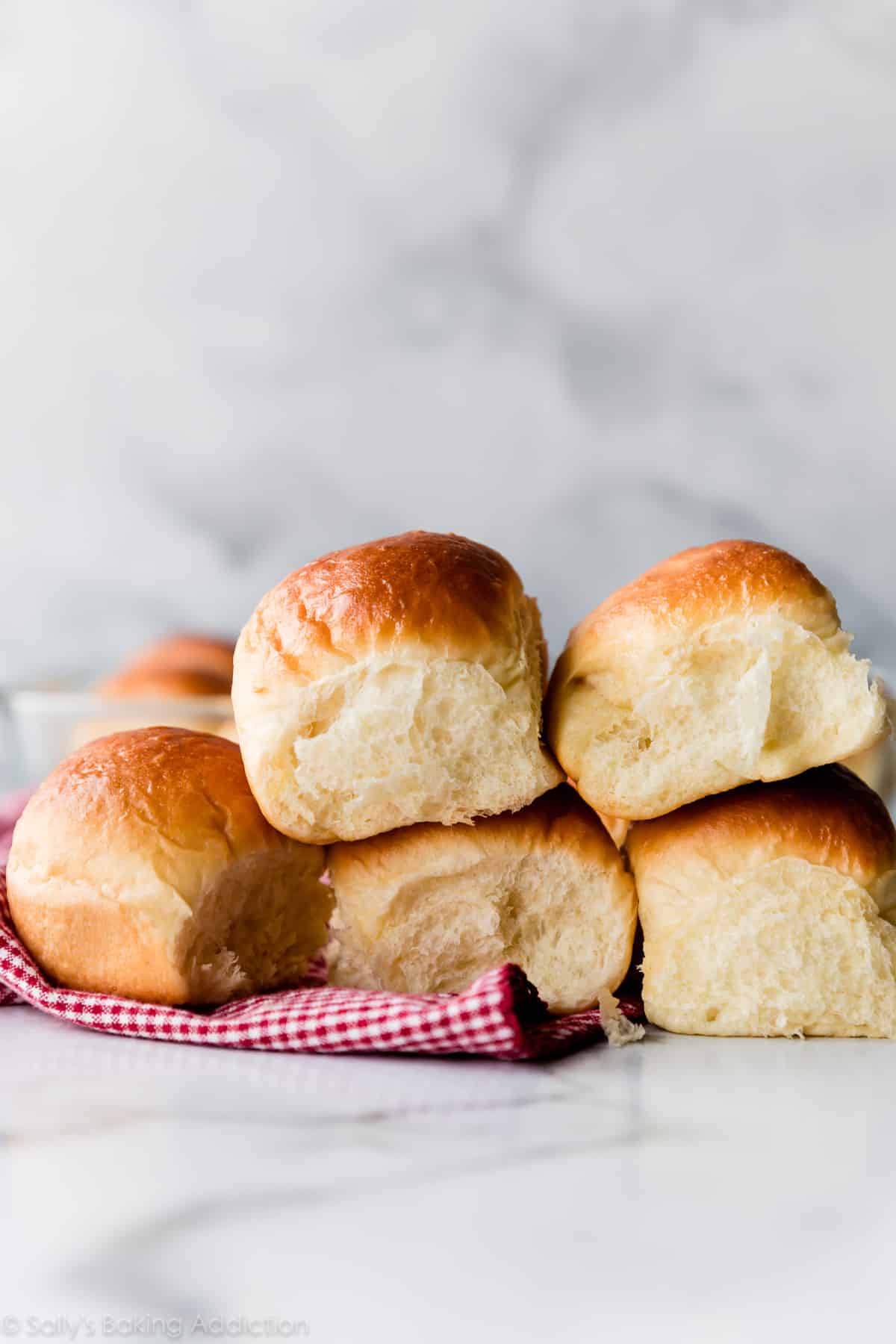
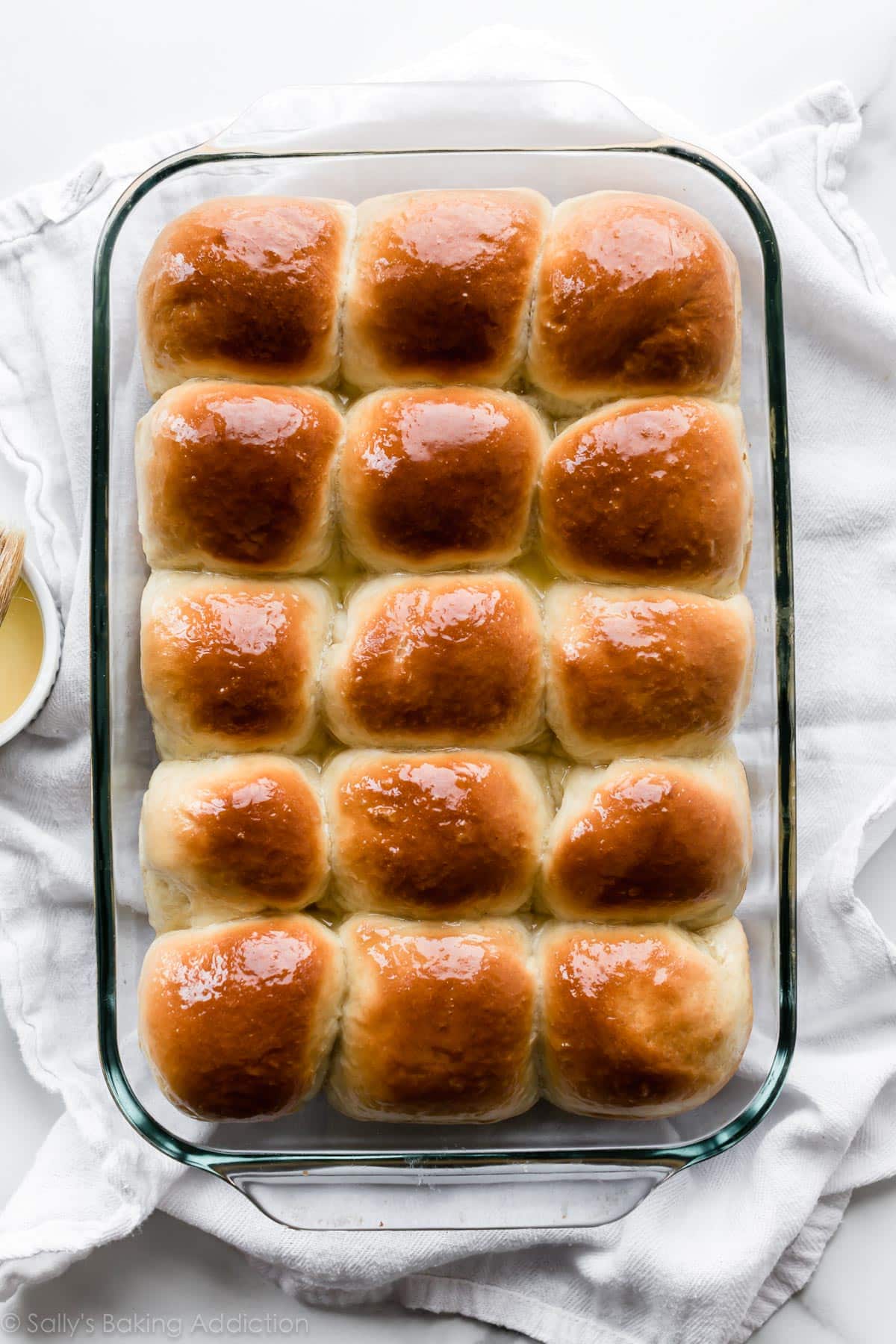
Dinner Roll Flavors
How about some pizazz? Mix in these ingredients when you add the flour.
- Rosemary Dinner Rolls – 2 Tablespoons fresh or dried chopped rosemary.
- Cheddar Dinner Rolls – 1 cup shredded cheddar cheese. Other cheese varieties work, but avoid super soft cheeses.
- Garlic & Herb Dinner Rolls – 2 teaspoons each: dried rosemary, dried basil, & dried parsley, along with 1 teaspoon garlic powder.
- Whole Wheat Dinner Rolls
- Brown Butter Sage Dinner Rolls
- Honey Butter Rolls
- Multigrain Rolls – Here is my Multigrain Bread recipe that you can turn into rolls.
They’re also fantastic with a simple swipe of homemade honey butter.
This dough is not ideal for a big loaf of bread. Instead, I recommend using a leaner dough, such as my sandwich bread or whole wheat bread recipes. If you need an egg free dough, try homemade breadsticks instead. And if you love pizza, try these pizza pull apart rolls next!
3 Success Tips
- Reference my Baking with Yeast Guide, which answers many common yeast FAQs.
- Make sure your yeast isn’t expired. Expiration date is on the package.
- Directly from the pros at Red StarYeast: Measuring flour correctly is key to avoiding a dense dough, which leads to heavy (not soft!) rolls. Spoon and level your flour, do not scoop it out of the package.
My final piece of advice? Don’t limit these rolls to suppertime. They’re welcome anywhere, with any meal, any time of day. Use for sliders, breakfast sandwiches, soaking up your favorite tomato sauce with slow cooker turkey meatballs, alongside salad, or dunking into a bowl of creamy chicken noodle soup. Above all, don’t doubt yourself because you, too, can become a bread baking pro.
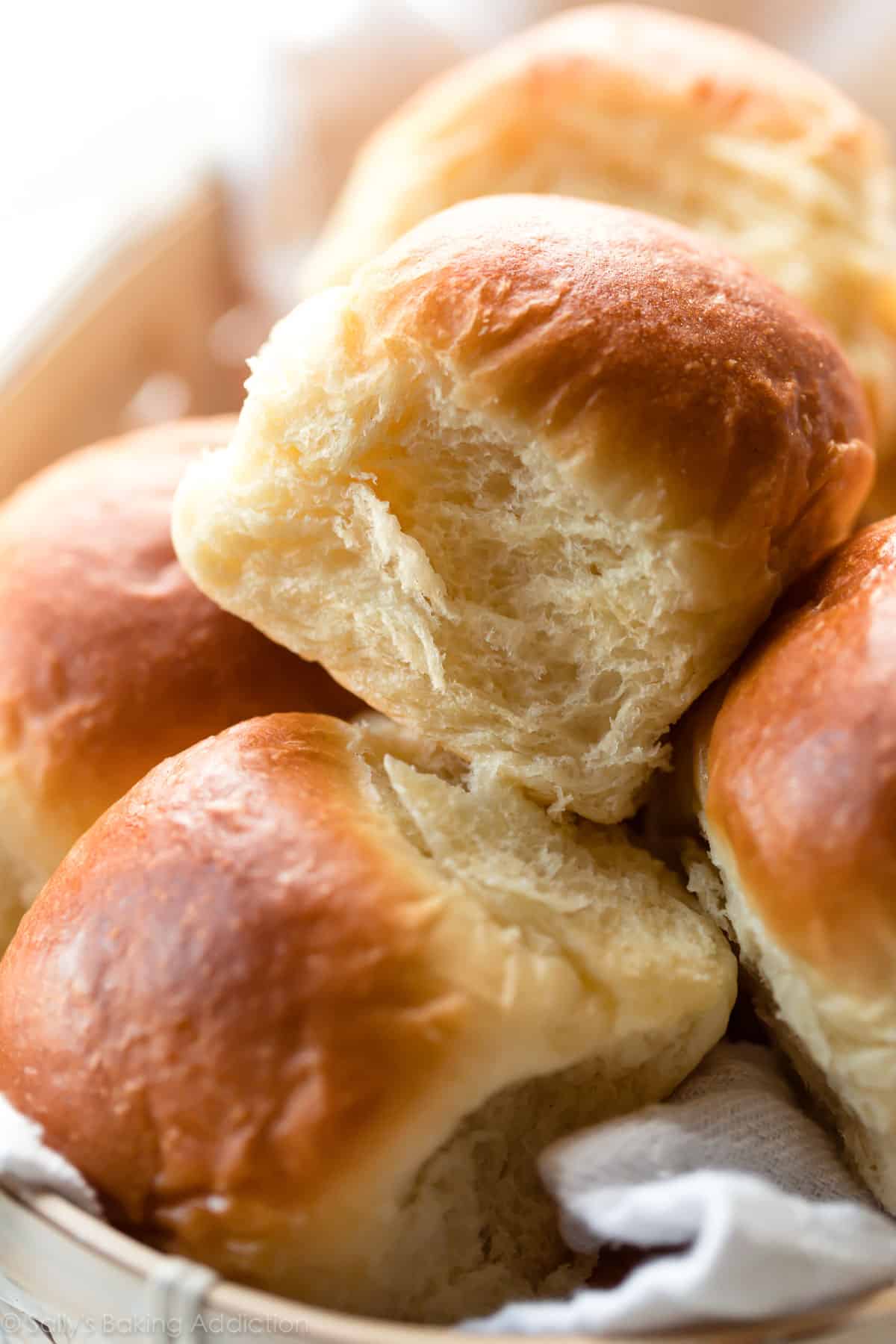
See Your Dinner Rolls!
Many readers have made this recipe! Feel free to email or share your recipe photos on social media. 🙂
Print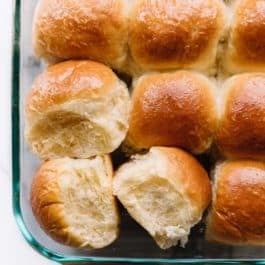
Soft Dinner Rolls Recipe
- Prep Time: 3 hours, 25 minutes
- Cook Time: 22 minutes
- Total Time: 3 hours, 45 minutes
- Yield: 14-16 rolls
- Category: Dinner
- Method: Baking
- Cuisine: American
Description
You only need 7 ingredients to make these dinner rolls. Flaky, soft, and buttery, these fresh dinner rolls outshine any main dish. See recipe notes for freezing and overnight instructions. You can also reference my Baking with Yeast Guide for answers to common yeast FAQs.
Ingredients
- 1 cup (240ml) whole milk, warmed to about 110°F (43°C)
- 2 and 1/4 teaspoons Platinum Yeast from Red Star instant yeast (1 standard packet)
- 2 Tablespoons granulated sugar, divided
- 1 large egg
- 1/4 cup (4 Tbsp; 56g) unsalted butter, softened to room temperature and cut into 4 pieces
- 1 teaspoon salt
- 3 cups (390g) all-purpose flour or bread flour* (spooned & leveled)
- optional topping: 2 Tablespoons (28g) melted unsalted butter mixed with 1 Tablespoon honey
Instructions
- Prepare the dough: Whisk the warm milk, yeast, and 1 Tablespoon of sugar together in the bowl of your stand mixer. Cover and allow to sit for 5 minutes. *If you do not own a stand mixer, you can do this in a large mixing bowl and in the next step, mix the dough together with a large wooden spoon/silicone spatula. It will take a bit of arm muscle. A hand mixer works, but the sticky dough repeatedly gets stuck in the beaters. Mixing by hand with a wooden spoon or silicone spatula is a better choice.*
- Add the remaining sugar, egg, butter, salt, and 1 cup flour. With a dough hook or paddle attachment, mix/beat on low speed for 30 seconds, scrape down the sides of the bowl with a silicone spatula, then add the remaining flour. Beat on medium speed until the dough comes together and pulls away from the sides of the bowl, about 2 minutes. If the dough seems too wet to a point where kneading (next step) would be impossible, beat in more flour 1 Tablespoon at a time until you have a workable dough, similar to the photos above. Dough should be soft and a little sticky, but still manageable to knead with lightly floured hands.
- Knead the dough: Keep the dough in the mixer and beat for an additional 5 full minutes, or knead by hand on a lightly floured surface for 5 full minutes. (If you’re new to bread-baking, my How to Knead Dough video tutorial can help here.) If the dough becomes too sticky during the kneading process, sprinkle 1 teaspoon of flour at a time on the dough or on the work surface/in the bowl to make a soft, slightly tacky dough. Do not add more flour than you need because you do not want a dry dough. After kneading, the dough should still feel a little soft. Poke it with your finger—if it slowly bounces back, your dough is ready to rise. You can also do a “windowpane test” to see if your dough has been kneaded long enough: tear off a small (roughly golfball-size) piece of dough and gently stretch it out until it’s thin enough for light to pass through it. Hold it up to a window or light. Does light pass through the stretched dough without the dough tearing first? If so, your dough has been kneaded long enough and is ready to rise. If not, keep kneading until it passes the windowpane test.
- 1st Rise: Lightly grease a large bowl with oil or nonstick spray. Place the dough in the bowl, turning it to coat all sides in the oil. Cover the bowl with aluminum foil, plastic wrap, or a clean kitchen towel. Allow the dough to rise in a relatively warm environment for 1-2 hours or until double in size. (I always let it rise on the counter. Takes about 2 hours. For a tiny reduction in rise time, see my answer to Where Should Dough Rise? in my Baking with Yeast Guide.)
- Grease a 9×13 inch baking pan or two 9-inch square or round baking pans. You can also bake the rolls in a cast iron skillet or on a lined baking sheet.*
- Shape the rolls: When the dough is ready, punch it down to release the air. Divide the dough into 14-16 equal pieces. (Just eyeball it– doesn’t need to be perfect!) A bench scraper is always helpful for cutting dough. Shape each piece into a smooth ball. Arrange in prepared baking pan.
- 2nd Rise: Cover shaped rolls with aluminum foil, plastic wrap, or a clean kitchen towel. Allow to rise until puffy, about 1 hour.
- Adjust oven rack to a lower position and preheat oven to 350°F (177°C). (It’s best to bake the rolls towards the bottom of the oven so the tops don’t burn.)
- Bake the rolls: Bake for 20-25 minutes or until golden brown on top, rotating the pan halfway through. If you notice the tops browning too quickly, loosely tent the pan with aluminum foil. Remove from the oven, brush with optional honey butter topping, and allow rolls to cool for a few minutes before serving.
- Cover leftover rolls tightly and store at room temperature for 2-3 days or in the refrigerator for up to 1 week.
Notes
- Freezing Instructions: Prepare recipe through step 6. Place shaped rolls in a greased baking pan, cover tightly, and freeze for up to 3 months. Once frozen, the dough balls won’t stick together anymore and you can place them in a freezer bag if needed. On the day you serve them, arrange the dough balls in a greased baking pan, cover tightly, then let them thaw and rise for about 4-5 hours. Bake as directed. You can also freeze the baked dinner rolls. Allow them to cool completely, then freeze for up to 3 months. Thaw in the refrigerator or at room temperature, then reheat as desired. If reheating the whole pan, lightly cover and reheat in a 300°F (149°C) oven for about 10 minutes or until warm.
- Overnight Instructions: Prepare the recipe through step 6. Cover the shaped rolls tightly and refrigerate for up to about 15 hours. At least 3 hours before you need them the next day, remove the rolls from the refrigerator, keep covered, and allow to rise on the counter for about 1-2 hours before baking. Alternatively, you can let the dough have its 1st rise in the refrigerator overnight. Cover the dough tightly and place in the refrigerator for up to about 15 hours. Remove from the refrigerator and allow the dough to fully rise for 2 more hours. Continue with step 5.
- Special Tools (affiliate links): Electric Stand Mixer or Glass Mixing Bowl and Wooden Spoon / Spatula | 9×13-inch Glass Baking Pan | Bench Scraper | Pastry Brush
- Baking Pan: I prefer baking the rolls in a glass 9×13 inch baking pan because I find they brown a little too quickly in metal. As long as you bake the rolls on a lower oven rack and keep your eye on them, any pan is great.
- Yeast: Platinum Yeast from Red Star is an instant yeast. You can use Red Star Yeast active dry yeast instead. Rise times will be slightly longer using active dry yeast. Reference my Baking with Yeast Guide for answers to common yeast FAQs.
- Flour: You can use all-purpose flour or bread flour. All-purpose flour is convenient for most, but bread flour produces chewier dinner rolls. The rolls are still soft and fluffy no matter which you use. Either flour is fine and there are no other changes to the recipe if you use one or the other.
Adapted from Homemade Bread Bowls and Honey Butter Rolls
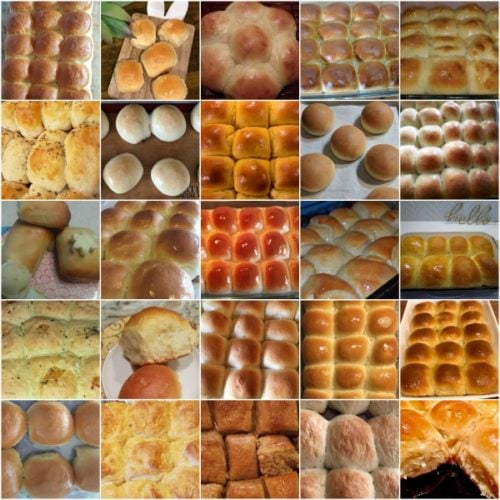
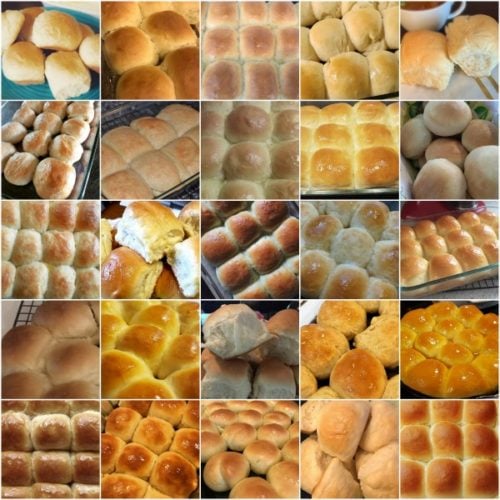
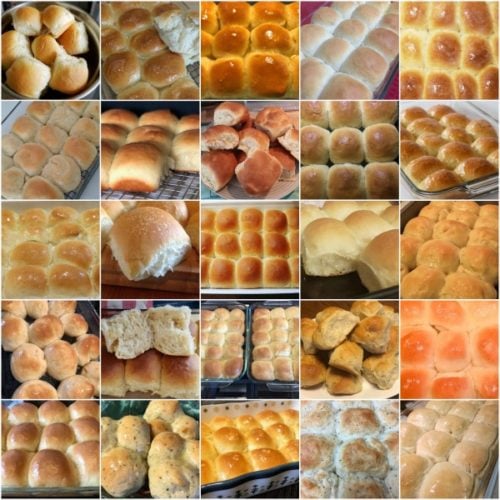
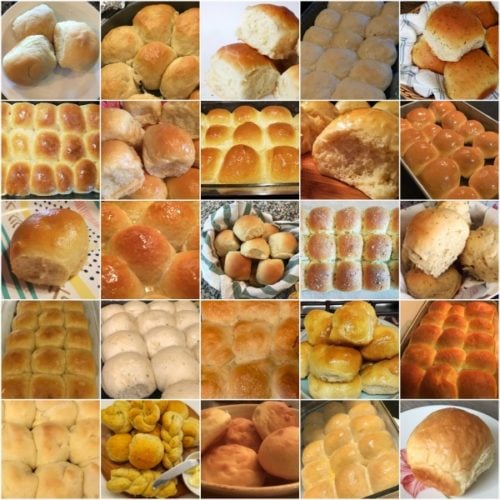
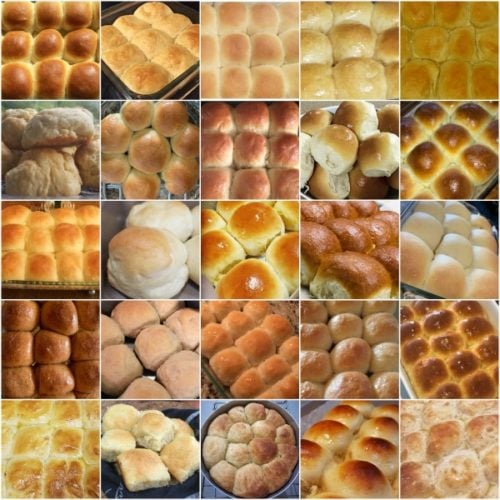
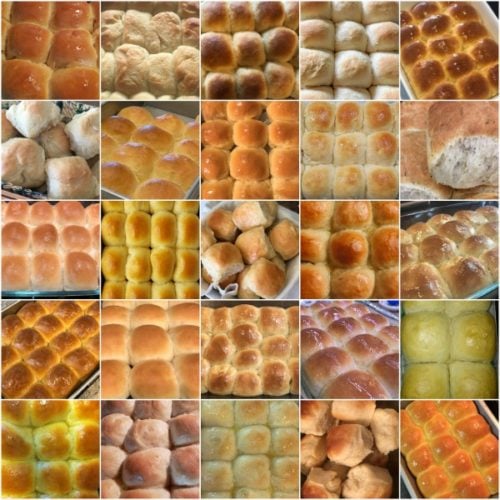
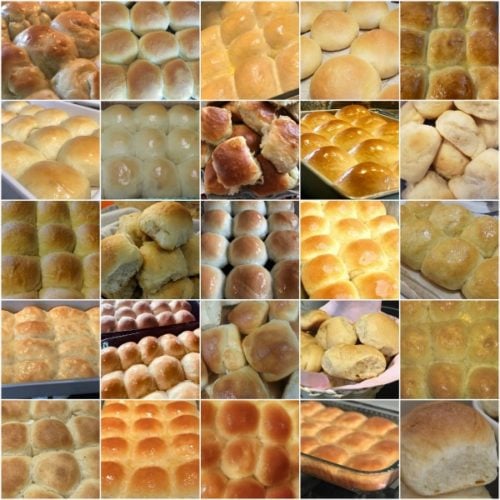
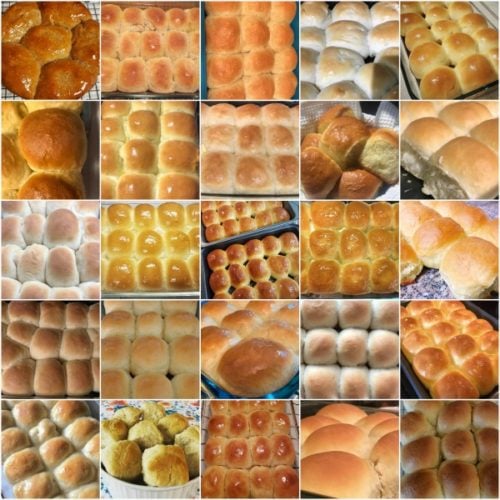
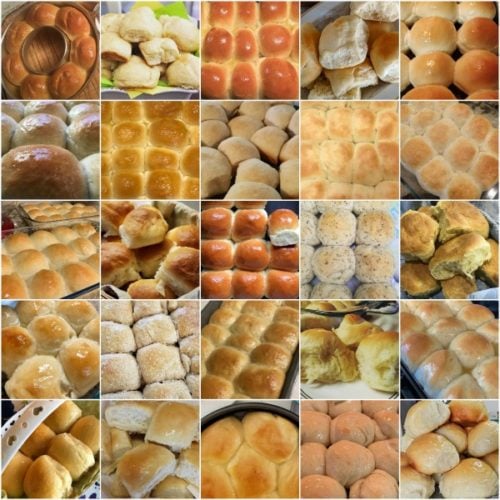
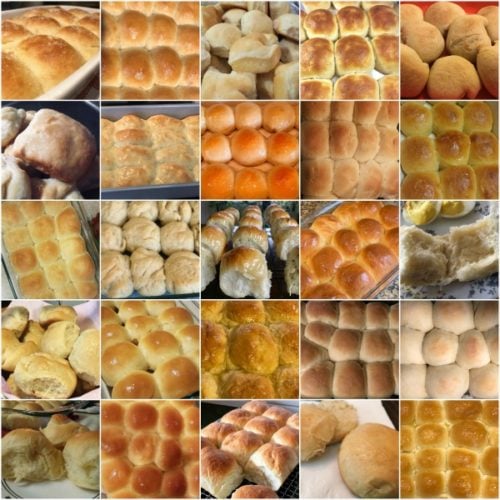
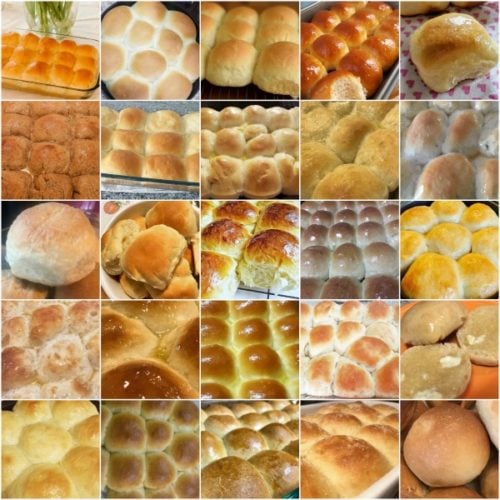
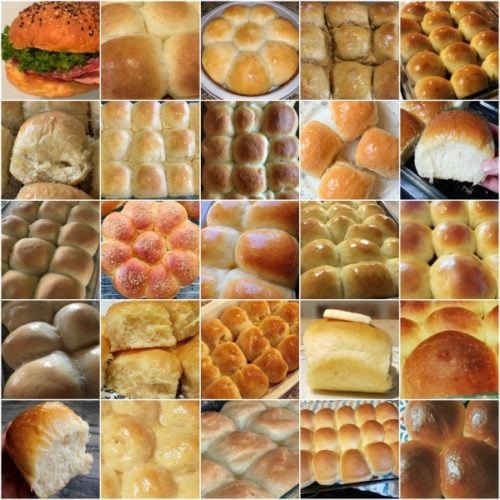
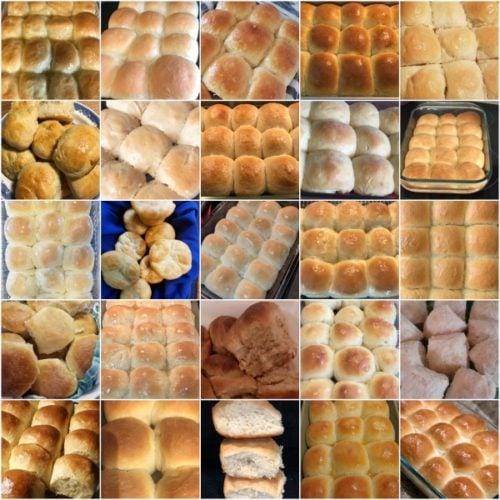
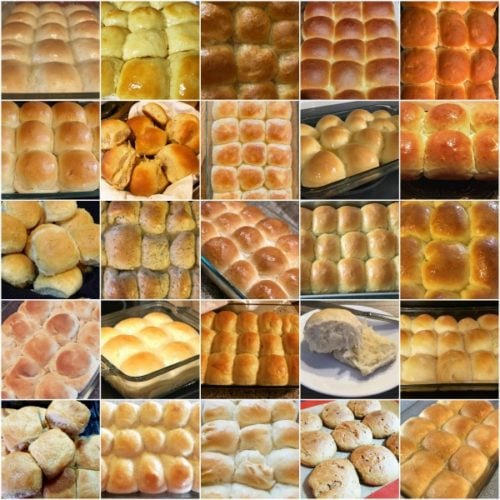
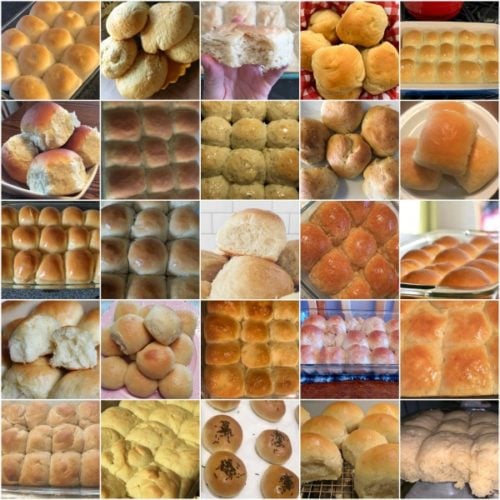
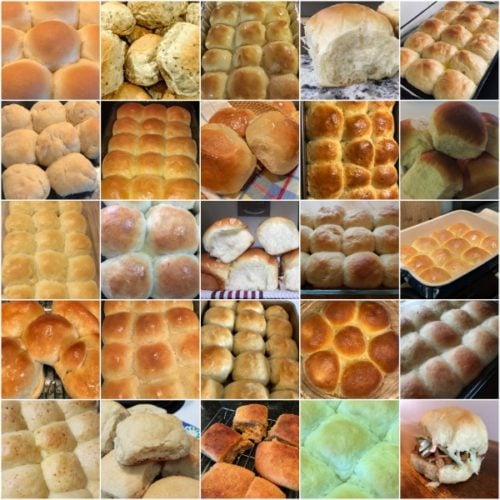
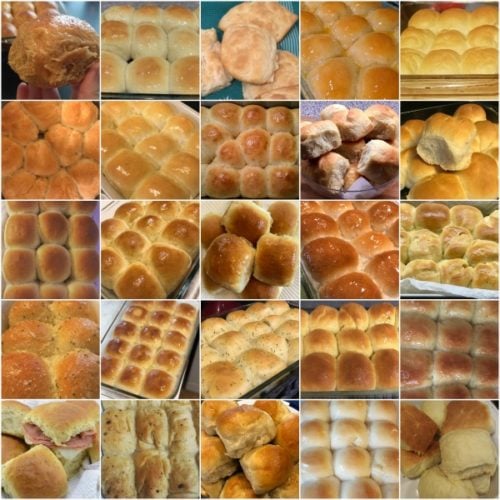
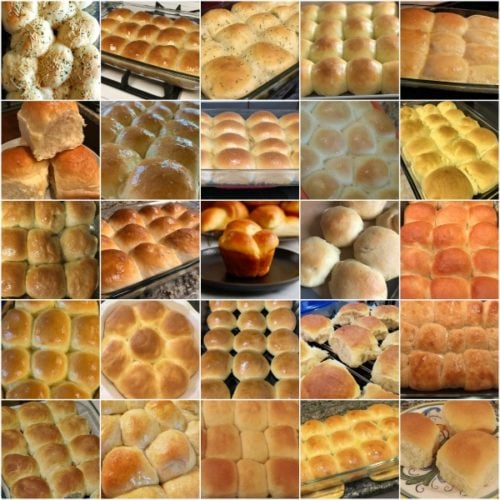
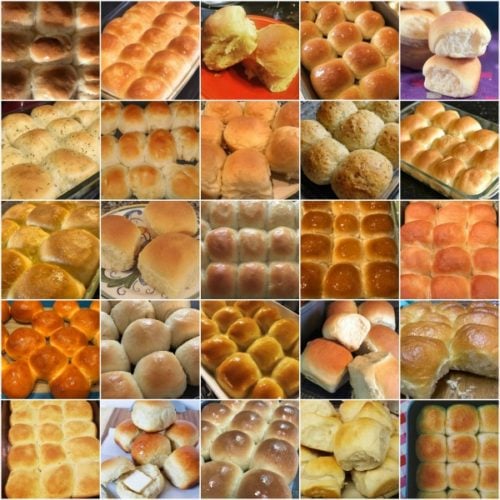
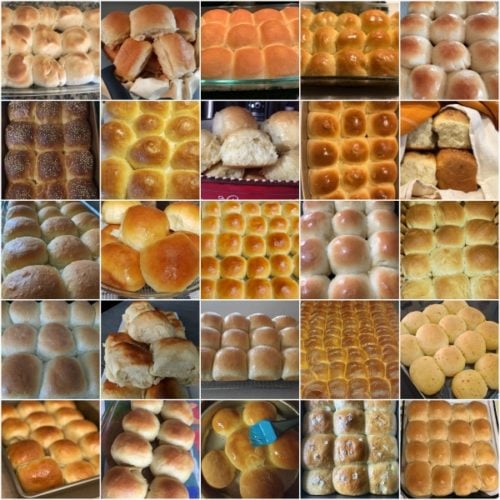





















I loved this recipe so much!
I don’t usually leave ratings but these buns had these buns a hard shell on them. I have made buns before and was just looking for a small batch recipe. Disappointed
Hi Peggy, it sounds like your dough may be over kneaded, causing the outsides to become hard and tough. You can try slightly decreasing your knead time, just until the dough slowly bounces back when poked with a finger. Be sure to also spoon and level (or use a kitchen scale) to measure your flour to ensure it isn’t over measured. Too much flour can cause the rolls to become dry. Thank you for giving these a try.
I learned how to knead dough from you and so far have been successful in almost every recipe of yours! I make them as is and I love them all! I have even started experimenting with flavors too, thank you so much for all your recipes! I’ve made these dinner rolls multiple times and they’ve yet to fail me, even when I messed up the order of the ingredients, it is very forgiving.
Followed the recipe exactly. But they turned out with a hard outer shell? I hand kneaded for the 5 minutes, let it rise etc. I baked for 20 mins with rotating them half way through. When I took them out they had a hard outer shell and weren’t soft at all. Any idea what I can do next time?
Hi Samantha, it sounds like your dough may have been over kneaded, causing the outsides to become hard and tough. You can try slightly decreasing your knead time, just until the dough slowly bounces back when poked with a finger. Hope this helps!
I followed this recipe to a T (except I didn’t add honey to the butter topping) and turned this recipe into hot dog buns. From this recipe, I was able to get ten buns. I used two 8×8 pans and put five buns in each. These were the best hot dog buns we’ve ever had! They were nice and moist even after sitting out for several days. I’ve been on the hunt for a good hot dog bun recipe and I believe this is it! I love that this recipe is multi-purpose – can be used for rolls, hot dog buns and I bet it’d make excellent hamburger buns too!
We’re so happy to read this, Bonnie!
First time making anything that involved yeast. Success! However, mine were a little drier than I thought they’d be. I baked them for 20 minutes. I did not top with the honey butter. Should Iuse a little more butter in the recipe? Does the honey butter topping make all the difference?
Hi Joan! They shouldn’t be dry without the honey butter. Perhaps they were slightly over-baked, or there was a little too much flour in the dough. Make sure to spoon and level (or use a kitchen scale) when measuring!
The whole family loved the dinner rolls!! Turned out perfect. Can this recipe be doubled. Or is better to make it one batch at a time?
Hi Lynsey, for best results, we recommend making separate batches rather than doubling. So glad these were a hit!
I’ve been making these rolls for years and they always turn out so fluffy and delicious. A tried and true recipe that kicks off my baking season every fall!
I only got 9 rolls out of this. They didn’t rise any bigger
Hi Ashley, did the dough not rise from the start? We’d check to make sure that your yeast is not expired and that the warm milk is not so hot that it kills the yeast. Over-kneading the dough can also prevent the dough from rising properly. Our Baking with Yeast Guide will be a helpful resource to review if you wish to try these again.
I thought anything over 100 degrees would kill the yeast. I see that the milk is heated to 110 degrees?
Hi DH, it takes higher temperatures to kill the yeast. This 110 degrees helps activate the yeast, but doesn’t kill it.
I’ve made these several times and they are always amazing. This time tho I ended up forgetting to add the egg. Do you know if it will still come out about the same? I’ve read up on it some for breads and most say it should be fine without it but wasn’t sure for this recipe.
Hi Destiny! The rolls won’t be quite as soft without the egg, but will still turn out just fine.
I tried this recipe as a loaf and it was gone in 20 mins, my family loved it
Hi!! You mentioned in step 1 that if you don’t have a mixer you can do it with your hands. What about for step 2? Can this step also be done by hand, and if so how long should it be done for?
Hi Alli, In step 2, you can mix by hand with a wooden spoon or silicone spatula until your dough is soft and a little sticky, but still manageable to knead with lightly floured hands.
This recipe is easy to follow. I must of done something wrong .. mine came out more like a biscuit center vs dinner roll.. over needing? Under kneading .. newbie here
Hi Faye, How did you measure the flour? Make sure to spoon and level (instead of scooping) to avoid packing in too much flour into your measuring cups – or use a kitchen scale. Over kneading bread can also cause it to be tough and dense. Thank you for giving these a try!
I find KitchenAid mixers or any mixers just don’t do justice anymore. Hand Kneading dough is just so much better. You’ll notice a difference right away. Takes some arm strength though but the execution is amazing. These people that said “dump in the bowl..” that’s just called laziness.. go buy dinner rolls at that point.
I love this recipe, I have been making it for two years or more, and today, I made rolls and bread,I put a small pan of water in my oven with it and it comes out even better. I also make your triple chocolate cake it’s the best .
My husband RAVES about these. I have made them several times and they always come out perfect!
Followed recipe to the T and my dough is so dense and heavy
Hi Bailey, how did you measure the flour? Make sure to spoon and level (instead of scooping) to avoid packing in too much flour into your measuring cups – or use a kitchen scale. Over kneading bread can also cause it to be tough and dense. Hope these tips help for next time. Thank you for giving these a try!
This was easy to follow and always a hit! However, whenever I freeze them they do not rise later. Any suggestions?
Hi Merlaine, we’re happy to help! After you freeze the dough be sure that you are letting the rolls thaw and rise for at least 4-5 hours. While ours usually rise during that time frame, it’s possible that yours might take longer depending on how long it was frozen and the temperature of your kitchen. If the dough it still cold it may not rise properly. Hope this helps!
I have never baked bread or anything with yeast for that matter and these instructions were so thorough and easy to follow that I wasn’t nervous to try it! And the rolls turned out incredible!! I’ve already eaten 2 right out of the oven. I can’t wait to make them again!
So glad these rolls were a hit, Lauren!
Hi, I used herby cream cheese instead of butter and they were fantastic
Hi! Why do we have to “prepare” the yeast with milk if it is instant?
Hi Monica, this helps ensure the yeast is activated and not expired or dead, before proceeding with the other ingredients.
I only tried making bread after my retirement so I am still a novice. This is so easy for me to follow.I love it!!
Not 10 minutes into baking these rolls, the family started to appear in the kitchen, sniffing around. My daughter is not a huge bread fan, but she was ready to taste test. The honey butter was the icing on top. She ended up having a little roll for breakfast and packed on in her lunchbox too.
Excellent recipe and easier to make than I thought it would be (I’m definitely a bread making novice.).
These rolls are a tradition now with our family. The family say they are just like Grandmother’s but better. 🙂 That is quite a complement as her rolls were demanded as special occasions by everyone. These are soft, wonderful, light and fluffy. Thank you!
One of my favorite roll recipes that’s manageable for a busy household of 6. I definitely do the kitchen aid thing too after the milk, yeast, and sugar sits. Quick and easy and they turn out great.
Definitely a keeper!
Can you make these recipe in metric? I don’t know how many grams the yeast is. I can google but I’ve had this issue for several recipe.
This is my favorite recipe site, btw. EVERYTHING comes out amazing, even though I’m stuck using different ingredients as my family lives in Burundi. ❤️
Hi Cordi, a standard packet of dry yeast is 7g. Hope this helps!
So good! Pretty easy recipe with simple ingredients and a great turnout. The family loved them at dinner. Thank you!
Can I use 2% milk?
Hi Heidi, 2% will work in a pinch.
Dude…. I dumped everything into the bowl of my kitchenaid and let it run until it pulls away from the sides. I’m sure all these extra steps help? But just so you know, they’re really not necessary.
this was great I loved making it
🙂
Unfortunately, these were just ok. And I definitely would not say these are “pillow soft”. But they’re not bad. Just not great. I would skip this recipe next time.
Followed the recipe exactly and it came out so perfect. I’m excited to try the flavor variations next!